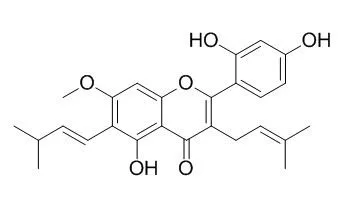| Description: |
Artocarpin has anti- bactericidal effect, can reduce the viability of pneumococci by a factor of >1000, without obvious harm to lung epithelial cells. Artocarpin can prevent skin damage from UVB irradiation-induced photodamage in hairless mice and this is likely mediated through its antioxidant and anti-inflammation mechanisms.Artocarpin possesses potent 5alpha reductase inhibitory effect, it induces apoptosis in HSC-1 and T47D cells through modulation of MAPK and Akt/mTOR pathways, an extrinsic pathway, respectively. Artocarpin has an efficient lightening effect on UV-stimulated hyperpigmented dorsal skins of brownish guinea pigs. |
| In vitro: |
| Evid Based Complement Alternat Med. 2015;2015:236159. | | Artocarpin Induces Apoptosis in Human Cutaneous Squamous Cell Carcinoma HSC-1 Cells and Its Cytotoxic Activity Is Dependent on Protein-Nutrient Concentration.[Pubmed: 25648333] | Artocarpin, a natural prenylated flavonoid, has been shown to have various biological properties. However, its effects on human cutaneous squamous cell carcinoma (SCC) have not been previously investigated.
METHODS AND RESULTS:
We set out to determine whether Artocarpin has cytotoxic effects on SCC cells and whether its pharmacological activity is dependent on protein-nutrient concentration. Our results showed that treatment of HSC-1 cells (a human cutaneous SCC cell line) with Artocarpin decreased cell viability and induced cell apoptosis by increasing caspase 3/7 activity. These effects were more pronounced at low fetal bovine serum (FBS) concentrations. Artocarpin induced an increase in the level of phospho-p38 and a decrease in the levels of phospho-ERK, phospho-JNK, phospho-Akt, phospho-mTOR, and phospho-S6K. High FBS concentrations in the culture media inhibited and delayed the uptake of Artocarpin from the extracellular compartment (culture media) into the intracellular compartment, as determined by high performance liquid chromatography (HPLC) analysis.
CONCLUSIONS:
In conclusion, Artocarpin induces apoptosis in HSC-1 cells through modulation of MAPK and Akt/mTOR pathways. Binding of Artocarpin to proteins in the FBS may inhibit cellular uptake and reduce the cytotoxic activity of Artocarpin on HSC-1 cells. Therefore, Artocarpin may have potential use in the future as a form of treatment for cutaneous SCC. | | Int J Med Microbiol. 2015 May;305(3):289-97. | | Antipneumococcal activity of neuraminidase inhibiting artocarpin.[Pubmed: 25592264] | Streptococcus (S.) pneumoniae is a major cause of secondary bacterial pneumonia during influenza epidemics. Neuraminidase (NA) is a virulence factor of both pneumococci and influenza viruses.
METHODS AND RESULTS:
Bacterial neuraminidases (NAs) are structurally related to viral NA and susceptible to oseltamivir, an inhibitor designed to target viral NA.
This prompted us to evaluate the antipneumococcal potential of two NA inhibiting natural compounds, the diarylheptanoid katsumadain A and the isoprenylated flavone Artocarpin. Chemiluminescence, fluorescence-, and hemagglutination-based enzyme assays were applied to determine the inhibitory efficiency (IC(50) value) of the tested compounds towards pneumococcal NAs. The mechanism of inhibition was studied via enzyme kinetics with recombinant NanA NA. Unlike oseltamivir, which competes with the natural substrate of NA, Artocarpin exhibits a mixed-type inhibition with a Ki value of 9.70 μM.
CONCLUSIONS:
Remarkably, Artocarpin was the only NA inhibitor (NAI) for which an inhibitory effect on pneumococcal growth (MIC: 0.99-5.75 μM) and biofilm formation (MBIC: 1.15-2.97 μM) was observable. In addition, we discovered that the bactericidal effect of Artocarpin can reduce the viability of pneumococci by a factor of >1000, without obvious harm to lung epithelial cells. This renders Artocarpin a promising natural product for further investigations. |
|






 Cell. 2018 Jan 11;172(1-2):249-261.e12. doi: 10.1016/j.cell.2017.12.019.IF=36.216(2019)
Cell. 2018 Jan 11;172(1-2):249-261.e12. doi: 10.1016/j.cell.2017.12.019.IF=36.216(2019) Cell Metab. 2020 Mar 3;31(3):534-548.e5. doi: 10.1016/j.cmet.2020.01.002.IF=22.415(2019)
Cell Metab. 2020 Mar 3;31(3):534-548.e5. doi: 10.1016/j.cmet.2020.01.002.IF=22.415(2019) Mol Cell. 2017 Nov 16;68(4):673-685.e6. doi: 10.1016/j.molcel.2017.10.022.IF=14.548(2019)
Mol Cell. 2017 Nov 16;68(4):673-685.e6. doi: 10.1016/j.molcel.2017.10.022.IF=14.548(2019)